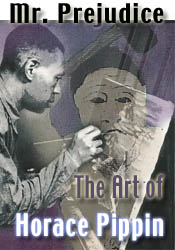The Life of an African-American disabled artist in the 20th century
 |
|
by Leroy Moore Jr./ Illin and Chillin The life, art, and writings of Horace Pippin can shed some light in our times of the so—called ‘War on Terrorism’ that we are forced to live in today. The strength and dedication of Mr. Pippin is a light from the past that follows our brothers and sisters onto the battlefields and in the airwaves of today. Horace Pippin was born in 1888 in West Chester, PA. but moved to New York as a child. At a very early age Pippin had a passion to draw, but had to leave school to help his family. The long, hard hours didn’t leave much time for drawing. He was known for his bold narrative paintings of war experiences etc. Horace Pippin’s paintings displayed the horror, pain, struggles of war and the life of African Americans during his time. His first major work, ‘The End of the War: Starting Home’ showed the horror he had seen in World War I. and at the beginning of WWII Pippin continued to stressed peace. “There was war then, but there would be peace again” was the message in Pippin’s painting, “The Holly Mountain,” which showed rows of white crosses marking the dead of WWI. Horace Pippin was a corporal in the 369-Colored Infantry Regiment, which fought on the front lines of WWI in the Argonne Forest under French command. These were the first African American soldiers to fight overseas for the United States on the front lines. “As a boy I loved to make pictures, but it was World War I that brought out the art in me… I can never forget suffering and I will never forget the sunset… so I came home with all of it in my mind and I paint from it today.” Horace Pippin explained in his book about his life and art, Starting Home: The Story of Horace Pippin Painter and his papers. Diving into a hole to escape a German sniper but he was unsuccessful. The sniper shot him in the shoulder with an exploding dumdum bullet. Every time Pippin tried to climb out, the sniper fired again. He remembered a French solider looking down at him and ten seconds later the solider was shot and fell on top of him in the whole. Pippin was not rescued from the hole until the next day. The doctors operated, attaching the shattered right shoulder to his upper arm with a steel plate. After the operation, Pippin couldn’t lift his right hand above shoulder level. He returned home and lived off his disability pension. Horace picked up his drawing after the war as therapy for not only his arm but also his battle with depression. He used his left hand to support his weak right hand to paint. Although Pippin loved painting, it was painful for him. This could be one reason why most of his paintings were small pictures and took him hours and days to complete one painting. He didn’t paint for fame he lived an honest life. His later paintings dealt with how African Americans were treated poorly after they returned home as you can see in his painting, Mr. Prejudice, that he painted after WWII because he saw more discrimination against the next generation of young African Americans soldiers. Please look at these painting and get to know the art and life of Mr. Horace Pippin and ask yourself have we learned from the messages in Pippin's paintings A little bite of history for our so-called President and the disabled & general public!! |



